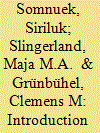| Srl | Item |
| 1 |
ID:
189808


|
|
|
|
|
| Summary/Abstract |
This article justifies structural, systemic, and functional requirements for the organizational and staff structure of tactical-level combined-arms formations based on an analysis of their assigned combat missions across a variety of scenarios and defines current trends of its development in the immediate and long term.
|
|
|
|
|
|
|
|
|
|
|
|
|
|
|
|
| 2 |
ID:
142200


|
|
|
| 3 |
ID:
145141


|
|
|
|
|
| Summary/Abstract |
This article argues that whilst the relationship between the Gulf Arab states and Asia is developing quickly, it will remain largely transactional for the foreseeable future. The relationship has intensified over the past 5 years and is manifest in increased trade, diplomatic traffic, foreign direct investment and energy relations. This has led some observers to argue that the Gulf Arab states will come to rely more upon Asian, rather than Western partners to provide for their security in the Gulf. The advent of the shale revolution and US energy independence has further underscored this line of analysis. The authors argue, however, that it is unlikely that the relationship between the Gulf Arab states and Asia will become strategic in the near future, as Asian leaders have shown no interest in guaranteeing Gulf security. They are content to bandwagon for as long as possible. Furthermore, the current security arrangement between Gulf Cooperation Council and Western powers, which has stood the test of time, looks likely to endure for decades. In spite of the apparent downturn in relations between Gulf Arab leaders and the West since the Arab Spring, both sides are committed to a long-term strategic relationship.
|
|
|
|
|
|
|
|
|
|
|
|
|
|
|
|
| 4 |
ID:
144846


|
|
|
|
|
| Summary/Abstract |
As part of the Thai Government's objective to increase energy security through biodiesel, oil palm was introduced to Northeast Thailand in 2005. Nong Khai Province was selected as a pilot project because of its suitable environmental conditions. This study assesses the acceptance of policy interventions and socio-economic conditions by adopters and non-adopters. We found that total farmland size was significantly higher among oil palm producers than among non-producers. Nevertheless, the area under oil palm cultivation did not increase in accordance with land size in the way rubber did. Oil palm and non-oil palm farmers had almost equal amounts of rice area thereby providing household food security. Oil palm did not replace food crops. Farmers investing in oil palm tend to base their livelihood around on-farm production, whereas non-adopters tend to diversify with off-farm income sources. Oil palm was found to be one component of a diversified farming system and an additional income source, albeit not the primary one. In conclusion, oil palm was a crop that had been tried by (wealthier) farmers with sufficient capital, and an aim to further diversify on-farm household income. Oil palm is certainly not (yet) contributing substantially to household income in Thailand's Northeast.
|
|
|
|
|
|
|
|
|
|
|
|
|
|
|
|
| 5 |
ID:
155647


|
|
|
| 6 |
ID:
155648


|
|
|
| 7 |
ID:
162977


|
|
|
|
|
| Summary/Abstract |
After Civil War (1936–1939), economic scarcity and political isolation reduced Spanish energy imports to about 10%. After a decade of stagnation, Spanish economy recovered, industrialized and boomed. Without domestic resources, this process largely depended on foreign imports. This paper analyzes the different actors involved in developing the infrastructural and institutional networks that enabled those imports. While it focuses on the Francoist regime (1939–1975) it is attentive to continuities and changes with respect to prior and, particularly, later periods.
|
|
|
|
|
|
|
|
|
|
|
|
|
|
|
|